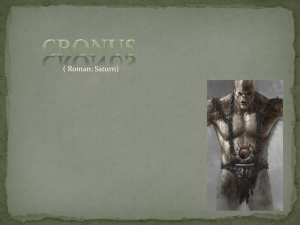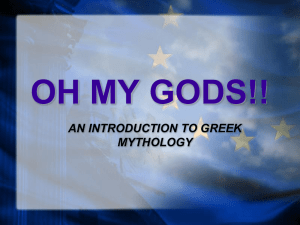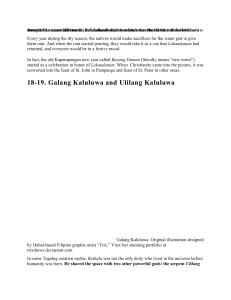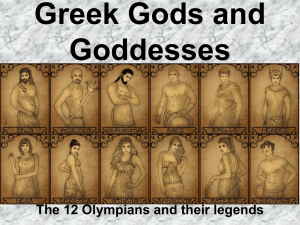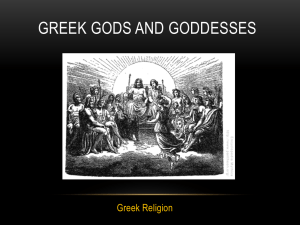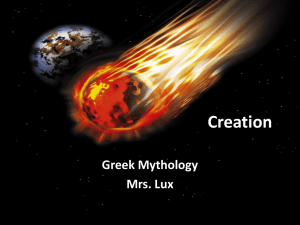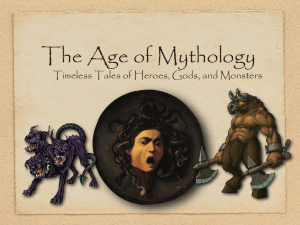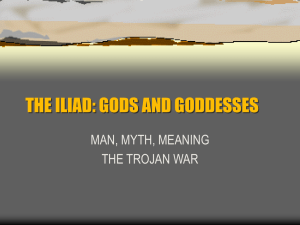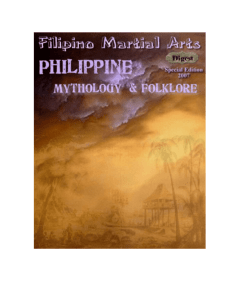Creation Myth - Mark Fullmer
advertisement
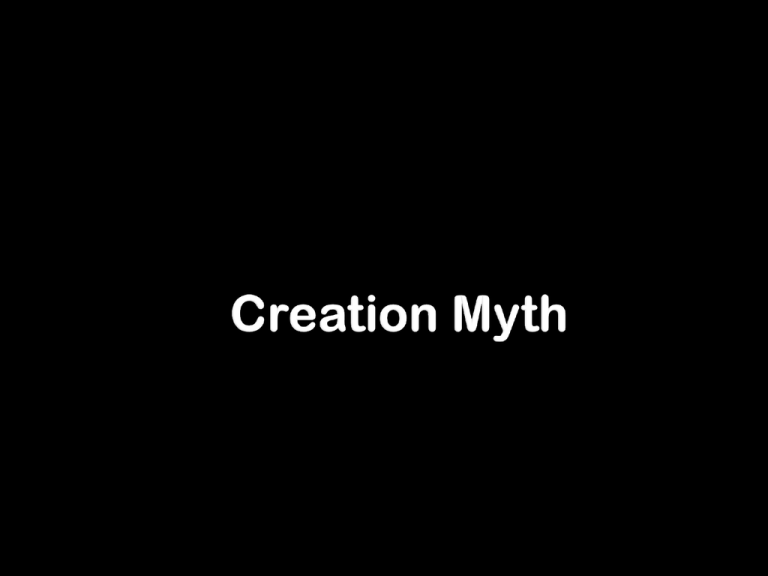
In the beginning of time there were three powerful gods who lived in the universe. Bathala was the caretaker of the earth, Ulilang Kaluluwa (lit. Orphaned Spirit), a huge serpent who lived in the clouds, and Galang Kaluluwa (lit. Wandering spirit), the winged god who loves to travel. These three gods did not know each other. Bathala often dreamt of creating mortals but the empty earth stops him from doing so. Ulilang Kaluluwa who was equally lonely as Bathala, liked to visit places and the earth was his favorite. One day the two gods met. Ulilang Kaluluwa, seeing another god rivalling him, was not pleased. He challenged Bathala to a fight to decide who would be the ruler of the universe. After three days and three nights, Ulilang Kaluluwa was slain by Bathala. Instead of giving him a proper burial, Bathala burned the snake's remains. A few years later the third god, Galang Kaluluwa, wandered into Bathala's home. He welcomed the winged god with much kindness and even invited him to live in his kingdom. They became true friends and were very happy for many years. Galang Kaluluwa became very ill. Before he died he instructed Bathala to bury him on the spot where Ulilang Kaluluwa’s body was burned. Bathala did exactly as he was told. Out of the grave of the two dead gods grew a tall tree with a big round nut, which is the coconut tree. Bathala took the nut and husked it. He noticed that the inner skin was hard. The nut itself reminded him of Galang Kaluluwa’s head. It had two eyes, a flat nose, and a round mouth. Its leaves looked so much like the wings of his dear winged friend. But the trunk was hard and ugly, like the body of his enemy, the snake Ulilang Kaluluwa. Bathala realized that he was ready to create the creatures he wanted with him on earth. He created the vegetation, animals, and the first man and woman. Bathala built a house for them out of the trunk and leaves of the coconut trees. For food, they drank the coconut juice and ate its delicious white meat. Its leaves, they discovered, were great for making mats, hats, and brooms. Its fiber could be used for rope and many other things. Thousands of years ago, there was no land, sun, moon, or stars, and the world was only a great sea of water, above which stretched the sky. The water was the kingdom of the god Maguayan, and the sky was ruled by the great god, Kaptan. Maguayan had a daughter called Lidagat, the sea, and Kaptan had a son known as Lihangin, the wind. The gods agreed to the marriage of their children, so the sea became the bride of the wind. A daughter and three sons were born to them. The sons were called Likalibutan, Liadlao, and Libulan, and the daughter received the name of Lisuga. Likalibutan had a body of rock and was strong and brave; Liadlao was formed of gold and was always happy; Libulan was made of copper and was weak and timid; and the beautiful Lisuga had a body of pure silver and was sweet and gentle. Their parents were very fond of them, and nothing was wanting to make them happy. After a time Lihangin died and left the control of the winds to his eldest son Likalibutan. The faithful wife Lidagat soon followed her husband, and the children, now grown up, were left without father or mother. However, their grandfathers, Kaptan and Maguayan, took care of them and guarded them from all evil. After some time, Likalibutan, proud of his power over the winds, resolved to gain more power, and asked his brothers to join him in an attack on Kaptan in the sky above. They refused at first, but when Likalibutan became angry with them, the amiable Liadlao, not wishing to offend his brother, agreed to help. Then together they induced the timid Libulan to join in the plan. When all was ready, the three brothers rushed at the sky, but they could not beat down the gates of steel that guarded the entrance. Likalibutan let loose the strongest winds and blew the bars in every direction. The brothers rushed into the opening, but were met by the angry god Kaptan. So terrible did he look that they turned and ran in terror, but Kaptan, furious at the destruction of his gates, sent three bolts of lightning after them. The first struck the copper Libulan and melted him into a ball. The second struck the golden Liadlao and he too was melted. The third bolt struck Likalibutan and his rocky body broke into many pieces and fell into the sea. So huge was he that parts of his body stuck out above the water and became what is known as land. In the meantime the gentle Lisuga had missed her brothers and started to look for them. She went toward the sky, but as she approached the broken gates, Kaptan, blind with anger, struck her too with lightning, and her silver body broke into thousands of pieces. Kaptan then came down from the sky and tore the sea apart, calling on Maguayan to come to him and accusing him of ordering the attack on the sky. Soon Maguayan appeared and answered that he knew nothing of the plot as he had been asleep deep in the sea. After some time, he succeeded in calming the angry Kaptan. Together they wept at the loss of their grandchildren, especially the gentle and beautiful Lisuga, but even with their powers, they could not restore the dead back to life. However, they gave to each body a beautiful light that will shine forever. And so it was the golden Liadlao who became the sun and the copper Libulan, the moon, while Lisuga's pieces of silver were turned into the stars of heaven. To wicked Likalibutan, the gods gave no light, but resolved to make his body support a new race of people. So Kaptan gave Maguayan a seed and he planted it on one of the islands. Soon a bamboo tree grew up, and from the hollow of one of its branches, a man and a woman came out. The man's name was Sikalak and the woman was called Sikabay. They were the parents of the human race. Their first child was a son whom they called Libo; afterwards they had a daughter who was known as Saman. Pandaguan, the youngest son, was very clever and invented a trap to catch fish. The very first thing he caught was a huge shark. When he brought it to land, it looked so great and fierce that he thought it was surely a god, and he at once ordered his people to worship it. Soon all gathered around and began to sing and pray to the shark. Suddenly the sky and sea opened, and the gods came out and ordered Pandaguan to throw the shark back into the sea and to worship none, but them. All were afraid except Pandaguan. He grew very bold and answered that the shark was as big as the gods, and that since he had been able to overpower it he would also be able to conquer the gods. Then Kaptan, hearing this, struck Pandaguan with a small lightning bolt, for he did not wish to kill him but merely to teach him a lesson. Then he and Maguayan decided to punish these people by scattering them over the earth, so they carried some to one land and some to another. Many children were afterwards born, and thus the earth became inhabited in all parts. Pandaguan did not die. After lying on the ground for thirty days he regained his strength, but his body was blackened from the lightning, and his descendants became the darkskinned tribe, the Negritos. As punishment, his eldest son, Aryon, was taken north where the cold took away his senses. While Libo and Saman were carried south, where the hot sun scorched their bodies. A son of Saman and a daughter of Sikalak were carried east, where the land at first was so lacking in food that they were compelled to eat clay. “Ex nihilo” creation “Creation from Chaos” “World Parent” creation “Emergence” creation “Earth-Diver” creation Also, be able to differentiate myth, rumor, superstition, legend, lore, & conspiracy theory Creation ex nihilo Also known as "creation de novo", is a common type of mythical creation. Ex nihilo creation is found in creation stories from ancient Egypt, the Rig Veda, the Bible and the Quran, and many animistic cultures in Africa, Asia, Oceania and North America. The Debate between sheep and grain is an example of an even earlier form of ex nihilo creation myth from ancient Sumer. In most of these stories the world is brought into being by the speech, dream, breath, or pure thought of a creator but creation ex nihilo may also take place through a creator's bodily secretions. The literal translation of the phrase ex nihilo is "from nothing" but in many creation myths the line is blurred whether the creative act would be better classified as a creation ex nihilo or creation from chaos. With ex nihilo, the potential and the substance of creation springs from within the creator. Such a creator may or may not be existing in physical surroundings such as darkness or water, but does not create the world from them. In creation from chaos the substance used for creation is pre-existing within the unformed void. Creation from chaos In creation from chaos myth, initially there is nothing but a formless, shapeless expanse. In these stories the word "chaos" means "disorder", and this formless expanse, which is also sometimes called a void or an abyss, contains the material with which the created world will be made. Chaos may be described as having the consistency of vapor or water, dimensionless, and sometimes salty or muddy. These myths associate chaos with evil and oblivion, in contrast to "order" (cosmos) which is the good. The act of creation is the bringing of order from disorder, and in many of these cultures it is believed that at some point the forces preserving order and form will weaken and the world will once again be engulfed into the abyss. World Parent (1) One form describes the primeval state as an eternal union of two parents, and the creation takes place when the two are pulled apart. The two parents are commonly identified as Sky (usually male) and Earth (usually female) who in the primeval state were so tightly bound to each other that no offspring could emerge. These myths often depict creation as the result of a sexual union, and serve as genealogical record of the deities born from it. In the second form of world parent myth, creation itself springs from dismembered parts of the body of the primeval being. Often in these stories the limbs, hair, blood, bones or organs of the primeval being are somehow severed or sacrificed to transform into sky, earth, animal or plant life, and other worldly features. These myths tend to emphasize creative forces as animistic in nature rather than sexual, and depict the sacred as the elemental and integral component of the natural world. In emergence myths humanity emerges from another world into the one they currently inhabit. The previous world is often considered the womb of the earth mother, and the process of emergence is likened to the act of giving birth. The role of midwife is usually played by a female deity, like the spider woman of Native American mythology. Male characters rarely figure into these stories, and scholars often consider them in counterpoint to male oriented creation myths, like those of the ex nihilo variety. Emergence myths commonly describe the creation of people and/or supernatural beings as a staged ascent or metamorphosis from nascent forms through a series of subterranean worlds to arrive at their current place and form. Often the passage from one world or stage to the next is impelled by inner forces, a process of germination or gestation from earlier, embryonic forms. The genre is most commonly found in Native American cultures where the myths frequently link the final emergence of people from a hole opening to the underworld to stories about their subsequent migrations and eventual settlement in their current homelands. The earth-diver is a common character in various traditional creation myths. In these stories a supreme being usually sends an animal into the primal waters to find bits of sand or mud with which to build habitable land. Some scholars interpret these myths psychologically while others interpret them cosmogonically. In both cases emphasis is placed on beginnings emanating from the depths. Earth-diver myths are common in Native American folklore but can be found among the Chukchi and Yukaghir, the Tatars and many Finno-Ugrian traditions. The pattern of distribution of these stories suggest they have a common origin in the eastern Asiatic coastal region, spreading as peoples migrated west into Siberia and east to the North American continent. In the beginning, Chaos, an amorphous, gaping void encompassing the entire universe, and surrounded by an unending stream of water ruled by the god Oceanus, was the domain of a goddess named Eurynome, which means "far-ruling" or "wide-wandering". She was the Goddess of All Things, and desired to make order out of the Chaos. By coupling with a huge and powerful snake, Ophion, or as some legends say, coupling with the North Wind, she gave birth to Eros, god of Love, also known as Protagonus, the "firstborn". Eurynome separated the sky from the sea by dancing on the waves of Oceanus. In this manner, she created great lands upon which she might wander, a veritable universe, populating it with exotic creatures such as Nymphs, Furies, and Charites as well as with countless beasts and monsters. Also born out of Chaos were Gaia, called Earth, or Mother Earth, and Uranus, the embodiment of the Sky and the Heavens, as well as Tartarus, god of the sunless and terrible region beneath Gaia, the Earth. Gaia and Uranus married and gave birth to the Titans, a race of formidable giants, which included a particularly wily giant named Cronus. In what has become one of the recurrent themes of Greek Mythology, Gaia and Uranus warned Cronus that a son of his would one day overpower him. Cronus therefore swallowed his numerous children by his wife Rhea, to keep that forecast from taking place. This angered Gaia greatly, so when the youngest son, Zeus, was born, Gaia took a stone, wrapped it in swaddling clothes and offered it to Cronus to swallow. This satisfied Cronus, and Gaia was able to spirit the baby Zeus away to be raised in Crete, far from his grasping father. In due course, Zeus grew up, came homeward, and got into immediate conflict with the tyrant Cronus, who did not know that this newcomer was his own son. Zeus needed his brothers and sisters help in slaying the tyrant, and Metis, Zeus's first wife, found a way of administering an emetic to Cronus, who then threw up his five previous children, who were Hestia, Demeter, Hera, Hades, and Poseidon. Together they went to battle against their father. The results were that all of his children, led by Zeus, vanquished Cronus forever into Tartarus' domain, the Dark World under the Earth. Thus, Zeus triumphed over not only his father, and his father's family of Giants, he triumphed over his brothers and sisters as well, dividing up the universe as he fancied, in short, bringing order out of Chaos. He made himself Supreme God over all, creating a great and beautiful place for his favored gods to live, on Mount Olympus, in Thessaly. All the others were left to fend for themselves in lands below Mount Olympus. Zeus made himself God of the Sky and all its phenomena, including the clouds as well as the thunderbolts. Hestia became goddess of the Hearth. To his brother Poseidon, he gave the rule of the Sea. Demeter became a goddess of Fertility, Hera (before she married Zeus and became a jealous wife), was goddess of Marriage and Childbirth, while Hades, one of his other brothers, was made god of the Underworld. Zeus did indeed bring order out of Chaos, but one of his failings was that he did not look kindly upon the people, those creatures that populated the lands over which he reigned. Many were not beautiful, and Zeus had contempt for anyone who was not beautiful. And of course they were not immortal, as the Olympian gods were, and they complained about the lack of good food and the everlasting cold nights. Zeus ignored their complaints, while he and the other gods feasted endlessly on steaming hot game from the surrounding forests, and had great crackling fires in every room of their palaces where they lived in the cold winter. Enter Prometheus, one of the Titans not vanquished in the war between Zeus and the giants. It is said in many myths that Prometheus had created a race of people from clay, or that he had combined specks of every living creature, molded them together, and produced a new race, The Common Man. At the very least he was their champion before Zeus. Fire for cooking and heating was reserved only for the gods to enjoy. Prometheus stole some of the sparks of a glowing fire from the Olympians, so that the people below Olympus could have fire for cooking and warmth in the winter, thus greatly improving their lot in life. Zeus was furious at this insult to his absolute power, and had Prometheus bound and chained to a mountain, sending an eagle to attack him daily. Adding insult to injury, Zeus had his fellow Olympian, Hephaestus, fashion a wicked but beautiful creature to torment Prometheus. It was a woman, whom they named Pandora, which means "all gifts". She was given a precious and beautiful box, which she was told not to open, but curiosity got the better of her, and out flew "all the evils that plague men." The only "gift" that stayed in the box was "Hope". So, from "far-ruling" Eurynome to the creation of the Common Man, Greek creation myths are inextricably filled with difficulties, though often ameliorated by the gift of Hope. A myriad of other myths tell of the joys and adventures of great heroes and heroines, other gods and goddesses, as well as fantastic creatures from all parts of ancient Greece.
